-
info@aaanimalcontrol.com
Call us for help in your town
Humane Wildlife Education
Other Species - Get Rid of Nuisance Wildlife
Need wildlife removal in your hometown? We service over 500 USA locations! Click here to hire us in your town and check prices - updated for year 2020. Select your animal below to learn more:
Alligator -
Beaver -
Beaver -
Chipmunks -
Coyote -
Stray Dogs -
Flying Squirrels -
Red & Gray Fox -
Muskrats -
Nutria -
Rabbit -
River Otter -
Porcupine -
Snapping Turtle -
Weasel & Mink -
Canada Geese -
Wild Pigs -
Frogs -
Iguanas -
Lizards -
Muscovy Ducks -
Prairie Dogs -
Starlings -
Voles -
Woodpeckers -
Mystery Animal
Alligator
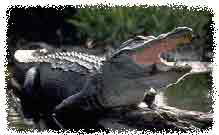 Biology: The American alligator is the largest reptile in North America. Alligators can be found in ponds, lakes, canals, rivers, and swamps in the southern
states, including Mississippi, Louisiana, and Florida.
Alligators are about 10"-12" in length when they are hatched from eggs. Females can grow to approximately 9' in length and 200+ pounds. Males
can grow to approximately 13'+ in length and reach 500+ pounds. The record alligator was 19 feet 2 inches. They can live to be 100 years old. When alligators mature their diet includes animals
such as muskrats, nutria, beaver, raccoons, large birds and fish, snakes, turtles, deer, etc. I wish that I could catch alligators, but the stinky
Florida Fish & Wildlife Commission restricts permits. Give them a call if you need alligator control.
Biology: The American alligator is the largest reptile in North America. Alligators can be found in ponds, lakes, canals, rivers, and swamps in the southern
states, including Mississippi, Louisiana, and Florida.
Alligators are about 10"-12" in length when they are hatched from eggs. Females can grow to approximately 9' in length and 200+ pounds. Males
can grow to approximately 13'+ in length and reach 500+ pounds. The record alligator was 19 feet 2 inches. They can live to be 100 years old. When alligators mature their diet includes animals
such as muskrats, nutria, beaver, raccoons, large birds and fish, snakes, turtles, deer, etc. I wish that I could catch alligators, but the stinky
Florida Fish & Wildlife Commission restricts permits. Give them a call if you need alligator control.
Nuisance Concerns: Alligators are considered a nuisance due to the potential danger they pose to pets or even children wandering near or swimming in Florida waters. Nobody wants an alligator taking up residence in their private pond or worse, swimming pool! More on how to get rid of alligators.
Top of page
Beaver
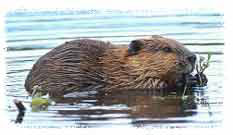 Biology: The beaver is the largest rodent found in North America. Adults can weigh up to 65 pounds
and measure from 24 to 36 inches, plus a tail of 12 to 18 inches. With its webbed hind feet,
waterproof fur, and unique paddle-shaped tail, the beaver is well-adapted to living in an aquatic environment. Beavers
are a major nuisance species in many parts of the country, but to be honest, I've never had to deal with a single
case here in Orlando.
Biology: The beaver is the largest rodent found in North America. Adults can weigh up to 65 pounds
and measure from 24 to 36 inches, plus a tail of 12 to 18 inches. With its webbed hind feet,
waterproof fur, and unique paddle-shaped tail, the beaver is well-adapted to living in an aquatic environment. Beavers
are a major nuisance species in many parts of the country, but to be honest, I've never had to deal with a single
case here in Orlando.Nuisance Concerns: Beavers are considered a nuisance for two primary reasons: tree cutting and dam building. Tree cutting is undesirable to landowners who want to protect their trees. Dam building is a more serious matter, resulting in flooding forest and farm lands, plugged culverts and the washout of roads.
Beavers do not respond to repellents, and they are impossible to exclude. They may abandon a dam site that is continually destroyed, but the most effective means of beaver control is trapping. More on how to get rid of beaver.
Top of page
Chipmunks
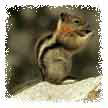 Biology: Chipmunks are rodents, best described as small ground-dwelling squirrels.
They are typically 5-6 inches long and weigh about three ounces. Chipmunks are omnivores.
Their diet consists primarily of grains, nuts, berries, seeds, and insects. They are
burrowing animals. They hibernate, and store food for the winter.
Biology: Chipmunks are rodents, best described as small ground-dwelling squirrels.
They are typically 5-6 inches long and weigh about three ounces. Chipmunks are omnivores.
Their diet consists primarily of grains, nuts, berries, seeds, and insects. They are
burrowing animals. They hibernate, and store food for the winter.Nuisance Concerns: Chipmunks are considered a nuisance because they may consume flower bulbs, fruits, seeds, and seedlings. When present in large numbers, they can also cause structural damage by burrowing under patios, stairs, retention walls, or foundations. More on how to get rid of chipmunks.
Top of page
Coyote
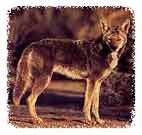 Biology: Coyotes are members of the canid family, which includes wolves, dogs and foxes.
Adults coyotes weigh an average of 30 to 50 pounds, and are four to five feet long from nose
to end of tail. They are carnivores, whose diet consists of rabbits, deer fawns, birds and
various invertebrates. They also scavenge and can bring down larger prey in packs. They raise
pups in dens, but seldom dig their own. They possess exceptional senses of smell, sight and
hearing, and can produce a distinct howl.
Biology: Coyotes are members of the canid family, which includes wolves, dogs and foxes.
Adults coyotes weigh an average of 30 to 50 pounds, and are four to five feet long from nose
to end of tail. They are carnivores, whose diet consists of rabbits, deer fawns, birds and
various invertebrates. They also scavenge and can bring down larger prey in packs. They raise
pups in dens, but seldom dig their own. They possess exceptional senses of smell, sight and
hearing, and can produce a distinct howl.Nuisance Concerns: Coyotes prefer solitude, but become a big nuisance when it comes to certain livestock. Occasionally, an individual coyote learns that chickens, sheep, lambs and calves are easy prey. Although there are some coyotes in the Orlando area, I never deal with them. More on how to get rid of coyotes.
Top of page
Stray Dogs
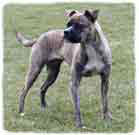 Dogs are often our beloved family pets. Unfortunately, many dogs do not have
homes, due to a variety of reasons. Some of them become a nuisance around town. They
can bark, harass other dogs, scavenge, and worst of all pose as a violent threat to
unsuspecting civilians. Others simply wander without homes, and still others have homes,
but have gotten themselves lost. If you find a stray dog, or are having problems due to
dangerous strays, contact the Animal Services division in your county, and they will
attempt to capture it and bring it to the local humane shelter. Look in your local BLUE PAGES
to find the correct phone number.
Dogs are often our beloved family pets. Unfortunately, many dogs do not have
homes, due to a variety of reasons. Some of them become a nuisance around town. They
can bark, harass other dogs, scavenge, and worst of all pose as a violent threat to
unsuspecting civilians. Others simply wander without homes, and still others have homes,
but have gotten themselves lost. If you find a stray dog, or are having problems due to
dangerous strays, contact the Animal Services division in your county, and they will
attempt to capture it and bring it to the local humane shelter. Look in your local BLUE PAGES
to find the correct phone number.More on how to get rid of stray dogs.
Top of page
Flying Squirrels
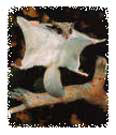 Biology: The northern flying squirrel is a small, nocturnal mammal weighing 3 to 5 ounces and
measuring 6 to 8 inches in total length. It has a long, broad, flattened tail, very eyes,
and thick, silky fur. It is a colonizing mammal. It does not actually fly, but uses
flaps of skin on either side of its body to glide through the air.
Biology: The northern flying squirrel is a small, nocturnal mammal weighing 3 to 5 ounces and
measuring 6 to 8 inches in total length. It has a long, broad, flattened tail, very eyes,
and thick, silky fur. It is a colonizing mammal. It does not actually fly, but uses
flaps of skin on either side of its body to glide through the air.Nuisance Concerns: Flying squirrels are a nuisance because they are colonizing animals. In the wild, they prefer hollowed out trees as nesting sites, but many decide that your attic is a swell environment. Because they are nocturnal, you may hear them scurrying about at night, particularly as they move in and out of the building. Many people hear the noise and mistake flying squirrels for rats, mice, or other types of squirrels, such as the Eastern Gray Squirrel. People don't like the noise that a colony of flying squirrels can make at night, nor do they appreciate the biohazard that the droppings pose. Flying squirrels chew, like all rodents, and can leave stains on your house at exit/entry sites. More on how to get rid of flying squirrels.
Top of page
Red & Gray Fox
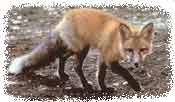 Biology: A medium-sized canid with a large bushy tail, often tipped in white. Ranges in
color from grayish and rust red to a flame red, usually reddish-brown. Adults measure
35-45 inches in length from nose to tip of tail and weigh between 12 and 18 pounds. Generally
moves at dusk and dawn, though may be active in mid day. Fox use a variety of habitats for
dens, including abandoned holes dug by other animals. Diet is varied, though it often
includes small mammals and birds.
Biology: A medium-sized canid with a large bushy tail, often tipped in white. Ranges in
color from grayish and rust red to a flame red, usually reddish-brown. Adults measure
35-45 inches in length from nose to tip of tail and weigh between 12 and 18 pounds. Generally
moves at dusk and dawn, though may be active in mid day. Fox use a variety of habitats for
dens, including abandoned holes dug by other animals. Diet is varied, though it often
includes small mammals and birds.Nuisance Concerns: Fox are a nuisance primarily for poultry producers. Turkeys, chickens, ducks, and geese are all susceptible to an opportunistic fox. Young pigs, lambs, and small pets are also killed by foxes. Foxes may carry rabies. Additionally, foxes have been known to steal pet food left outside for outdoor pets.
Several of the wildlife trappers listed on this national directory deal with fox problems. More on how to get rid of foxes.
Top of page
Groundhogs
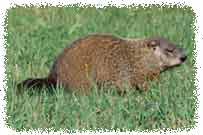 Biology: The groundhog, also known as the woodchuck, is a member of a group of large, ground-dwelling squirrels,
called marmots. Adult groundhogs measure 18 to 24 inches long and weigh about 6 to 10 pounds.
The woodchuck is almost a complete vegetarian, eating leaves, flowers and soft stems of various grasses, of field crops such
as clover and alfalfa, and of many kinds of wild herbs. Certain garden crops like peas, beans and
corn are favorites. Chucks occasionally climb trees to obtain apples and pawpaws which they relish.
Biology: The groundhog, also known as the woodchuck, is a member of a group of large, ground-dwelling squirrels,
called marmots. Adult groundhogs measure 18 to 24 inches long and weigh about 6 to 10 pounds.
The woodchuck is almost a complete vegetarian, eating leaves, flowers and soft stems of various grasses, of field crops such
as clover and alfalfa, and of many kinds of wild herbs. Certain garden crops like peas, beans and
corn are favorites. Chucks occasionally climb trees to obtain apples and pawpaws which they relish.Nuisance Concerns: Groundhogs are a nuisance primarily because of their tunneling ability. The are prodigious diggers, and often choose to dig burrows along edges, such as your house or deck. They can seriously undermine support of your house's foundation, deck, or outdoor stairs. It is important to eliminate groundhog tunnels next to a house. Its burrows are also dangerous to both horses and cattle. In addition, groundhogs will eat most of the crops in your garden if given access. More on how to get rid of groundhogs.
Top of page
Muskrats
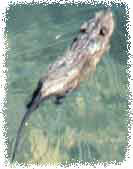 Biology: The muskrat is the largest member of the rat and mouse family (Cricetidae)
in North America. Adults weigh 3 to 4 pounds. The muskrat is adapted to an aquatic way of life,
and is an important and valuable furbearer. They live in family groups, each group occupying a
portion of a pond containing a house, feeding areas, and canals through cattails and other pond
vegetation. Muskrats eat pond weeds and emergent vegetation. They also eat a variety of animals,
including freshwater mussels, frogs, salamanders and small fish.
Biology: The muskrat is the largest member of the rat and mouse family (Cricetidae)
in North America. Adults weigh 3 to 4 pounds. The muskrat is adapted to an aquatic way of life,
and is an important and valuable furbearer. They live in family groups, each group occupying a
portion of a pond containing a house, feeding areas, and canals through cattails and other pond
vegetation. Muskrats eat pond weeds and emergent vegetation. They also eat a variety of animals,
including freshwater mussels, frogs, salamanders and small fish.Nuisance Concerns: Muskrats burrow in the banks of rivers, streams, and ponds. The primary concern is bank erosion. Of course, they pose a threat to dikes as well. Most of the calls we get are from people who don't like numerous burrows, which erode the bank or can be accidentally stepped in, on the edge of their private pond or stream. More on how to get rid of mukrats.
Top of page
Nutria
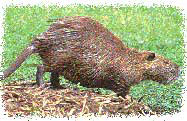 Biology: Nutria are members of the rodent family. Adult nutria are about 14 inches long from the nose to the base of the tail.
The tail itself is 12 to 17 inches long, round, and hairless. Nutria average 15 to 20 pounds in weight.
Nutria are native to South America. Nutria prefer to live in salt water shoreline mudflats and tidewaters.
Biology: Nutria are members of the rodent family. Adult nutria are about 14 inches long from the nose to the base of the tail.
The tail itself is 12 to 17 inches long, round, and hairless. Nutria average 15 to 20 pounds in weight.
Nutria are native to South America. Nutria prefer to live in salt water shoreline mudflats and tidewaters.Nuisance Concerns: They can disrupt catfish farming, destroy rice and sugar fields, and disrupt flood control. Nutria tear out aquatic plants by the roots to eat them. They are destroying many hectares of marsh vegetation, such as bullrush and cordgrass. When nutria eat all of the grasses in a marsh, the ecosystem is disrupted. This damage impacts wading birds, fish, mollusks, crustaceans, and many other organisms. The roundworms infesting nutria can cause health problems for man. The roundworm larvae is present in the water where nutria are found, and this larvae can penetrate human skin. Known as "nutria itch", severe inflammation can result, which requires medical attention. More on how to get rid of nutria.
Top of page
Cottontail Rabbit
 Biology: The Cottontail Rabbit is not in the rodent family. It is classified as a
Lagomorph. An adult cottontail is about 15 to 18 inches long and weighs between two and three pounds.
Litter sizes up to l0 have been reported, but typical litters number from 3 to 5 young, born
after a gestation period of about 28 days. Eastern Cottontails are herbivorous, eating a wide
variety of plant materials.
Biology: The Cottontail Rabbit is not in the rodent family. It is classified as a
Lagomorph. An adult cottontail is about 15 to 18 inches long and weighs between two and three pounds.
Litter sizes up to l0 have been reported, but typical litters number from 3 to 5 young, born
after a gestation period of about 28 days. Eastern Cottontails are herbivorous, eating a wide
variety of plant materials.Nuisance Concerns: Rabbits are primarily a nuisance due to crop damage. In high numbers, they can decimate your garden. Additionally, Tularemia is a bacterial disease of rabbits that is transmittable to humans, usually through openings in the skin. However, it's extremely rare. More on how to get rid of rabbits.
Top of page
River Otter
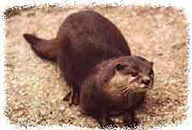 Biology: The river otter is the largest member of the Mustelidae family which
includes the mink, weasels, skunks and badger. Adult animals are three to four feet long, including the 12- to 1 8-inch tail, and generally weigh 15 to 25 pounds.
Otters are usually found in or near water and are well adapted for aquatic Life. Their streamlined bodies, webbed feet and long tails contribute to their
Biology: The river otter is the largest member of the Mustelidae family which
includes the mink, weasels, skunks and badger. Adult animals are three to four feet long, including the 12- to 1 8-inch tail, and generally weigh 15 to 25 pounds.
Otters are usually found in or near water and are well adapted for aquatic Life. Their streamlined bodies, webbed feet and long tails contribute to their
excellent swimming ability. Fish make up the greatest portion of the otter's diet. Crayfish are also an important food when available. Other foods include amphibians, insects, mammals and birds.
Nuisance Concerns: Not many, though otters occasionally cause depredation problems at fish hatcheries and rearing areas. As with all animals, their presence on your private property may be unwanted for a variety of reasons. There have also been recent cases of otters carrying the rabies virus. However, we're reluctant to trap this playful and uncommon animal. More on how to get rid of otters.
Top of page
Porcupine
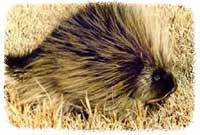 Biology: The porcupine is a rodent of about 20 inches long and 10 to 20 pounds. They are famous for their many
sharp quills, which are actually modified hairs, and used in self-defense. Porcupines are nocturnal.
They feed on a variety of plants and trees.
Biology: The porcupine is a rodent of about 20 inches long and 10 to 20 pounds. They are famous for their many
sharp quills, which are actually modified hairs, and used in self-defense. Porcupines are nocturnal.
They feed on a variety of plants and trees.Nuisance Concerns: Porcupines are considered a nuisance when they destroy trees or other wood, which they gnaw on, like all rodents. They can also choose your deck as a den site. They pose a potential danger because of the sharp, barbed quills. Like most animals, they are not aggressive, choosing flight over fight. More on how to get rid of porcupines.
Top of page
Snapping Turtle
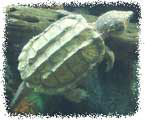 Biology: Snapping Turtles average 8-12 inches long and 10-35 pounds, though they can
grow to weights of up to 65 pounds Common snappers are at home in slow-moving streams, rivers, lakes and ponds.
They consume a variety of aquatic plants and many kinds of animals including fish, frogs, birds, and small
mammals. They are also effective scavengers and clean up dead fish and drowned animals.
Biology: Snapping Turtles average 8-12 inches long and 10-35 pounds, though they can
grow to weights of up to 65 pounds Common snappers are at home in slow-moving streams, rivers, lakes and ponds.
They consume a variety of aquatic plants and many kinds of animals including fish, frogs, birds, and small
mammals. They are also effective scavengers and clean up dead fish and drowned animals.Nuisance Concerns: Pond n. - A body of water surrounding a Snapping Turtle. If you own a pond, even a small one, there's a chance you've got a home for a Snapping Turtle or two. Snapping turtles are well-known for their aggressive behavior. Their strong jaws are capable of delivering a serious bite. Your pet might be in for a surprise should it encounter a nesting snapper on land. More on how to get rid of snapping turtles.
Top of page
Weasel & Mink
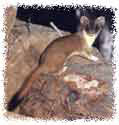 Biology: Weasels and mink are members of the same family, Mustelidae. Weasels are 10-16 inches
long, and mink 18-26. Their slender bodies allows them to enter tunnels to hunt for gophers and
other animals that live underground. They usually take up residence in the burrows of other
animals. They eat rabbits, rats, birds, frogs, ground squirrels, and of course, mice.
Biology: Weasels and mink are members of the same family, Mustelidae. Weasels are 10-16 inches
long, and mink 18-26. Their slender bodies allows them to enter tunnels to hunt for gophers and
other animals that live underground. They usually take up residence in the burrows of other
animals. They eat rabbits, rats, birds, frogs, ground squirrels, and of course, mice.Nuisance Concerns: Poultry farmers beware, the small weasel and mink are aggressive and can kill several chickens in one spree. More on how to get rid of weasels.
Top of page
Mystery Animal
 That scratching in the attic, that bump in the night, that howling on the wind ...it could be
anything! Or perhaps you saw some creature which you swear doesn't have a listing in the Audubon Society Guide To North American Mammals.
Well, don't trouble yourself over it any longer. Just call our crimestoppers and
we'll discover the identity of the culprit. We carefully examine every bit of evidence. Footprints!
Hair samples! Excriment samples! Telltale odors! Scratch marks! Chew marks! Bedding material! Hole size!
Type of noise! Environment of animal! Time of year! Time of day! DNA evidence! By golly, if it's there,
we will find it and bring it to justice. Call our crime lab any time.
That scratching in the attic, that bump in the night, that howling on the wind ...it could be
anything! Or perhaps you saw some creature which you swear doesn't have a listing in the Audubon Society Guide To North American Mammals.
Well, don't trouble yourself over it any longer. Just call our crimestoppers and
we'll discover the identity of the culprit. We carefully examine every bit of evidence. Footprints!
Hair samples! Excriment samples! Telltale odors! Scratch marks! Chew marks! Bedding material! Hole size!
Type of noise! Environment of animal! Time of year! Time of day! DNA evidence! By golly, if it's there,
we will find it and bring it to justice. Call our crime lab any time.Top of page
Wondering how to get rid of nuisance wildlife? There is no magic spray or device that you can use to make them go away. Some people try to sell predator urine, such as coyote or fox urine to get rid of mice, but that doesn't work. They also try to sell ultrasonic sound emitters. These devices are worthless at eliminating nuisance wildlife. Some old wive's tales recommend the use of mothballs or ammonia-soaked rags to make them leave, but I've been to countless homes where these techniques failed - biologists know that these attempts won't work. The ONE AND ONLY WAY to take care of your problem is with trapping and removal of the animals. If you need to find a professional trapper in your home town, just click our comprehensive list of hundreds of wildlife removal professionals, and you can have your problem quickly taken care of!
Read other articles:
How To Clean Wild Animal Waste In Your Attic
How to remove a live animal stuck down a wall
How to get wild animals out of a wall
How to keep away voles
How to remove an animal living under a shed or porch
What to do about a wild animal under the porch
How to get an animal out of a tree
How to trap voles
How to trap stray cats
How to trap feral hogs
What equipment is needed to trap a wild animal?
How to track wild animals
What are some of the symptoms of a sick wild animal?
What if you are bitten by a stray cat
What to do if you have stray cats living in an attic
Will a high pitch sound deterrent machine repel wild animals?
What is a snare trap?
What is a snare pole and how to use it
Removal of honey bees from house
How to stop beavers eating trees
How to tear down a beaver dam
Is it safe to handle a wild animal with bare hands?
What is the best bait to trap a wild animal?
Are baby wild animals cute?
How do I know if there are baby wild animals in the attic?
How To Keep Wild Animals Away
How to Clean Wild Animal Waste in Your Attic
Will repellents get a wild animal out of the attic?
Noises in attic but no droppings
What animals like to live in attics?
Can wild animals in the attic give your pets fleas?
Will a wild animal in the attic have a nest of babies?
What is in my attic?
Do all wild animals have rabies? (no)
How to keep away alligators
What should I do with a wild animal after I catch it?
How to keep wild animals out from under a shed or porch
Scratching Sounds In the Attic or Walls
What is the best way to repair a hole a rodent chewed in your house?
What materials can rodents chew through?
How to get rid of voles
Will repellents get a wild animal out of the chimney?
How to Repair Different Types of Wildlife Damage and Entry Holes
How to remove an animal living under a house
How to Remove a Wild Animal in the attic
What tools does a nuisance wildlife operator need?
How much does nuisance wildlife removal cost?
Do relocated wildlife thrive or have difficulty surviving?
Where should I relocate a trapped wild animal?
What do wildlife rehabilitators do with wild animals?
How to know if you have rabies
Problems Caused by Nuisance Wildlife
What causes rodent population growth and infestations?
What are the most common types of animals that poop on or in buildings?
Should you ever use poison to solve a wildlife problem?
Should I ever poison a wild animal?
What is the difference between pest control and wildlife removal?
Will a pest control company remove a wild animal?
Nuisance peacock removal
How to keep wild animals out of my garden
How to get wild animals out of the attic
What should I do if I find an orphaned baby wild animal wandering about?
What to do about a wild animal on the roof
What is a one way exclusion door?
How to make and use a one-way door to remove animals in a house
What should I do if I find a nest of wild animals in the attic?
Do mothballs or ammonia help repel wild animals?
How to get a wild animal out of a live trap
What are the most common types of animals that live in attics?
Is it legal for me to trap a wild animal?
How to kill voles
What are some ways to kill a wild animal in the yard?
What are some humane ways to kill a wild animal in a cage?
How to kill feral hogs
How to keep wild animals away from your property
What is Integrated Pest Management?
How to remove and replace insulation in an attic
What if a wild animal got inside my house, bedroom, kitchen, etc.
How do you know if you have a wild animal in your attic?
How to trap iguanas
How to get rid of iguanas
How to kill iguanas
How to keep away iguanas
How to keep wild animals out of your house
Different causes of bad odor in a house
How to keep away feral hogs
Should I hire a pro, or remove wild animals myself?
About the Green Anole
Do wild animals make good pets?
How to keep animals out of your garden
What are the most common types of animals that eat your garden?
How to keep wild animals out of my garbage cans
How to keep frogs out of your pool or house
How to identify fox tracks
Are foxes dangerous to cats, dogs, or other pets?
What is a foothold trap?
Exotic reptile species that live in the wild of Florida
Should I feed a baby wild animal I found?
Is wild animal feces dangerous to touch or breathe?
What is an exclusion barrier?
How to Inspect Your House to Find Wild Animal Entry Holes
Do wild animals have emotions?
How to find and hire an effective wildlife control professional
Animals in the eaves
What are the most common types of animals that eat your pet's food?
How do you remove a wild animal stuck in a dumpster?
What is Canine Distemper?
Wild Animal Diseases
What kinds of animals dig up your yard?
What wild animals can destroy the wood on your house?
What kinds of animals destroy gardens?
How to get a dead animal out of your car
What diseases do wild animals carry?
What are the most common types of animals that dig up the yard?
Is a wild animal that is active during the daytime rabid?
Are any nuisance wildlife dangerous to humans?
Will homeowners insurance pay for wild animal damage?
Do wild animals in an attic damage insulation? How?
What kind of damage do wild animals cause in an attic?
Cuban tree frogs in Florida
How to identify coyote tracks
Are coyotes dangerous to cats, dogs, or other pets?
How to get a job as a nuisance wildlife control operator
What is a Conibear trap?
How do I clean wild animal feces out of my attic?
Will the city or county animal services help me with a wild animal issue?
How to Remove a Wild Animal in the Chimney
How to get wild animals out of the chimney
What wild animals like to live in chimneys?
How to keep wild animals out of a chicken coop
What animals chew on electric wires?
What are the risks of animals chewing on electric wires?
Do animals chew on water pipes? What are the risks?
How to prevent rodents from chewing on your car's wires
How to keep away stray cats
What does stray cat feces look like? Where is it found?
How to catch a wild animal with a snare pole
What is the best brand of cage trap?
What to do about a cage-shy (hard to trap) wild animal








































